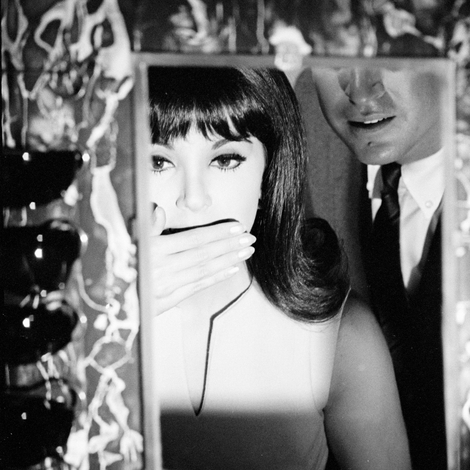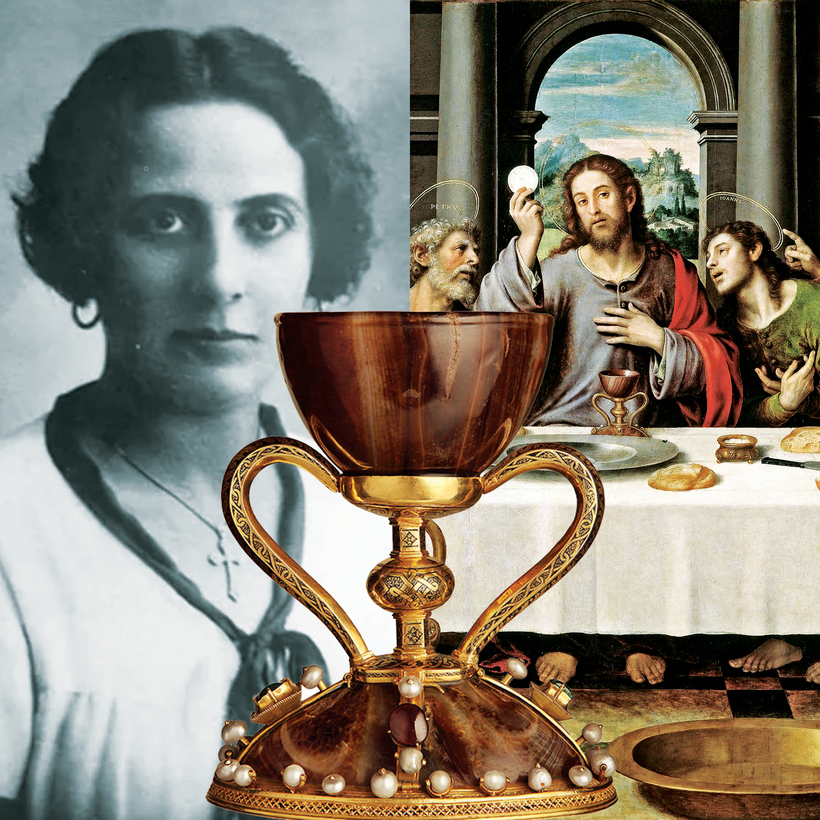It is a story that’s equal parts Indiana Jones, John le Carré, and outlandish sitcom: a woman was pursued by the British secret service and the Nazis during the Spanish Civil War because she’d hidden the Holy Grail—the cup from which Christ is said to have drunk during the Last Supper—in a sofa.
There is debate as to where the relic is today, or if it even existed in the first place. A source of myth and mystery, more than 200 goblets across Europe alone have been posited as the holy chalice. Some academics have dismissed the Grail legend as a literary invention of the Middle Ages. Others theorize it was spirited away by the Knights Templar and is currently locked away in Fort Knox. Yet if it really does exist, several of the more credible routes from Jerusalem point toward Spain.
Since 1437, the Valencia Cathedral has housed the cup most commonly credited as the true Grail by Western Christianity. The Santo Cáliz (Holy Chalice) comprises two parts: a blessing cup made of reddish-brown agate stone, and a carved-gold reliquary, into which the cup is set, with precious gems at its base.
In 1960, an archaeological study concluded that the cup dates from the second or first century B.C. and was made by hand somewhere between Palestine and Egypt—the only region where this type of agate is found. The gold stand dates from the 11th century, and is a means of showcasing it. It has passed through the hands of many popes. It’s thought to have been transported from Jerusalem to Rome by Saint Mark (a disciple of Saint Peter the Apostle, the first pope) around 60 A.D. and remained there until 258 A.D., when Pope Sixtus II is said to have given it to Saint Lawrence to take to Spain and keep it safe from persecution under Emperor Valerian. More recently, John Paul II and Benedict XVI used it when they visited Valencia in 1982 and 2006, respectively.
During the Spanish Civil War, which was fought between the Republican Communists and the insurgent Nationalist Fascists from July 1936 to April 1939, Valencia suffered from a heavy-handed Republican military presence, which was hostile toward members of the clergy. Priests, nuns, and bishops were brutally murdered, and churches were looted for items of value and sometimes burned to the ground.
On July 21, 1936, when half a dozen militia members burst through the Valencia Cathedral’s tall, Romanesque doors, worshippers feared what might happen. The Marxists made a beeline for the Gothic chapel where the Santo Cáliz was venerated, only to find that it wasn’t there. It wasn’t anywhere, in fact. They ransacked the place and, furious, overturned pews and set fire to the confessionals and the tabernacle, which spread to 16th-century tapestries and destroyed various relics.
The Republicans finally led away the youngest member of the clergy, José Gasch, and tortured him to find out where the Grail was.
Three hours earlier, once morning Mass at the altar of the Holy Trinity had finished, Monsignor Elías Olmos Canalda, the canon archivist, hung behind with four worshippers, including 40-year-old Sabina Suey. They knew the militia would likely take the sacred chalice from the chapel and that the church might never see it again.

Suey lifted the reliquary from the shrine by its snake-like gold handles, wrapped it in cotton wool, and placed it in a black zinc box a little wider than a shoebox. The box was then camouflaged in newspaper. The monsignor disappeared into the vestry and returned wearing a makeshift Republican-soldier uniform. He and Suey, who are thought to have known each other since she was a child (the deacon was over 10 years her senior), exited through a side door onto the Calle de la Barchilla and disappeared into Valencia’s medieval side streets.
They made their way across the cobbles to the home Suey shared with her sister and mother—Suey’s father had passed away some years earlier—700 feet from the cathedral at 3 Calle Avellanas, above what is now an e-bike-rental shop.
The Marxists made a beeline for the Gothic chapel where the Santo Cáliz was venerated, only to find that it wasn’t there. It wasn’t anywhere, in fact.
Some of these details were described in a small book Canalda wrote in 1952 titled Como fue salvado el Santo Cáliz de la Cena. However, the priest used this literary opportunity to belittle the importance of Suey, whose central role in this tale is now coming to light. Canalda had described her as “a cleaner,” which has been widely reported elsewhere. And while she may have volunteered to clean and polish items in her role as a church helper, she was in fact a respected postwoman and professional piano player who had studied under the celebrated Valencian pianist and conductor José Iturbi.
Ana Mafé Garcia, chair of the International Scientific Committee for Holy Grail Studies, suggests Canalda’s motive was misogyny. “The role of women has always been relegated by the Catholic Church. Don Elías … minimize[d] her effort to safeguard and protect the relic for years. I believe he did so out of pure ego. Suey never wanted awards or recognition.” Canalda died in 1961, and Suey followed in 1982.
I spoke with Garcia, who is organizing an exhibition on the Holy Grail at a journalism congress outside Valencia this October, which will highlight Suey’s role in rescuing the artifact, and with Suey’s niece, Amparo Doñate Suey, to try and get to the bottom of what happened during the two years and eight months of war when it was missing from view.
The further we get from these 20th-century conflicts, the more legends refract and swell. But this is, to the best of our knowledge, the story. And if it can’t be told perfectly, we have at least tried to get it right for posterity’s sake.
The Grail was initially hidden in Suey’s attic under a wardrobe. Republican units banged on her door three times in the space of a month, presumably because the deacon José Gasch had admitted under duress that Suey and Canalda had removed the treasure from the cathedral. On the third visit, on August 21, Iron Column commander José Pellicer discovered the zinc box and what was inside. Miraculously, he stayed shtum. Despite his anarchic politics, the goateed 24-year-old hailed from Valencia’s upper bourgeoisie and was educated by Jesuits. He is also said to have had a bit of an eye for Suey, which might have been the motivating factor. The following day, Pellicer returned and strongly advised Suey to find a new hiding place.
She moved the Grail a mile away to her brother Alfredo’s house on the Calle Pelayo, and the pair settled on secreting it among the springs of his sofa. Twice more, the militia showed up and tried their intimidation tactics on Alfredo, but the cup was never found.
Understandably tired of the attention, Alfredo conspired with his sister to move the Grail for a third time, now to the home of their cousin Bernardo Primo, approximately 20 miles south in the town of Carlet. Suey supposedly told Primo the box contained jewelry and didn’t elaborate. They buried the box in the thick adobe walls of the house. There are other stories, though, including one that had it hidden in a hollow of a window on the top floor of his house.
Despite Suey’s discretion and the Rojos’ failure to find anything, word of the Santo Cáliz’s disappearance and Suey and Canalda’s role in it had got out. Canalda later claimed a Jewish-Dutch antiques dealer based in Paris had offered seven million pesetas for the chalice, along with French passports. At the time, many priceless relics and antiquities were finding their way into American collections, and the antiques dealer believed such an item could fetch unimaginable sums at auction in New York.
According to Garcia’s research, Britain and Germany were also interested in acquiring the Grail. Both countries had significant intelligence presences in Spain at the time to influence events in the Nationalists’ and their own countries’ favor, and tensions between the British and the Nazis were already simmering.
It is said M.I.6—potentially led by Major Hugh Pollard, a devout Roman Catholic who helped orchestrate General Franco’s coup—approached Suey and offered her and her family safe passage to England in return for the Grail. They claimed to simply want the relic for its historic value and to protect it. But Suey didn’t trust them and denied any knowledge of the chalice’s whereabouts.
A more sinister approach is said to have been made by a wealthy notary from the municipality of Alboraya. Francisco Bosch y Navarro was a Germanophile, and was on friendly terms with Canalda. The details are scant, but the notary allegedly tried to broker an arrangement for representatives from the German embassy to meet Suey and Canalda with a seaplane. Heinrich Himmler, the head of the SS, and an officer close to him, the historian Otto Rahn, were known to be obsessed with the Grail, believing it held supernatural powers that would bring about a 1,000-year Reich. For Hitler, it would be the ultimate prize. But Suey refused to play ball, and somehow lived to tell the tale.
Maybe it was thanks to divine protection. Suey’s sister Maria had taken some of the cotton wool that swaddled the chalice and begun giving small pieces of it to friends who were fighting the Communists, without explanation. All of these men survived the war unscathed, including one who made a miraculous escape from a bombing.
Valencia was liberated on March 30, 1939, and Suey and Canalda, along with her sister and mother, went straight to Carlet to retrieve the zinc box and hand it to the Recovery Board of the National Artistic Treasure. On April 9, Holy Thursday, all were present and photographed at a ceremony at La Lonja, Valencia’s Gothic silk exchange—the cathedral was in no fit state to host such an event, following the desecration and destruction wrought by the Republicans—to celebrate the Santo Cáliz’s safe return.
Today, the Suey family still has the sofa in which the Grail was stored, swaddled in cotton among the rusting springs. And for years, says Suey’s niece, those little pieces of wool have worked magic.
“My uncle Adolfo, when he was young, he was very ill, and the doctor thought death was imminent,” Amparo recounts. “The family put a little piece of cotton under the pillow. The doctor came the next morning to certify the death of the child, but to his surprise the child was very alive.”
Adam Hay-Nicholls is the author of Charles Leclerc: A Biography and Smoke & Mirrors: Cars, Photography and Dreams of the Open Road


